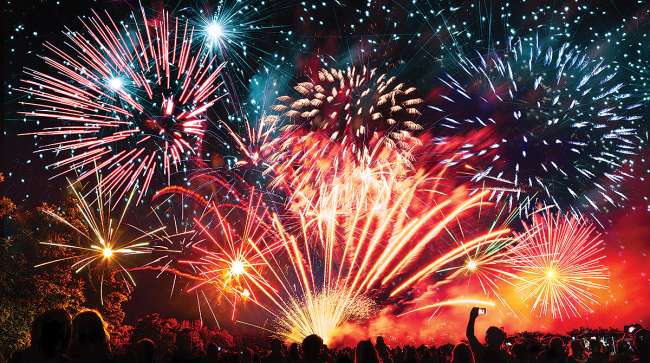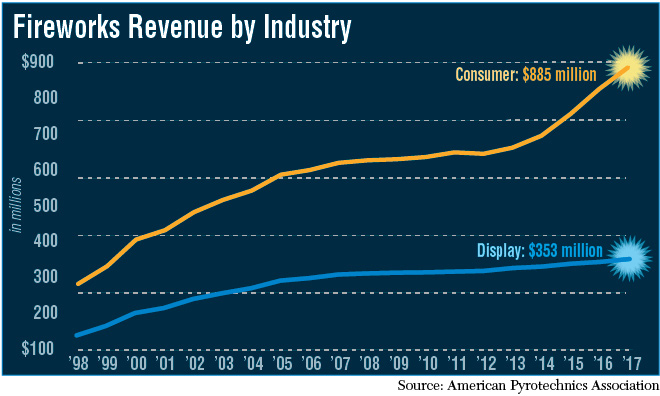Drivers Overcome Web of Regulations to Deliver Holiday Fireworks

Although they drive trucks only one to six times a year, drivers for American Pyrotechnics Association members face unique challenges related to federal transportation safety regulation.
Fireworks are rated Class 1 among hazardous materials, so some regulations can put a crimp in the pyrotechnic industry’s ability to meet the high demand for fireworks just ahead of the Fourth of July holiday celebration.
There are rules for traveling on bridges and through tunnels, and more rules for electronic logging devices and hours of service.
In addition to being trained to transport fireworks, drivers are often the lead pyrotechnician.
Driving is “incidental” to the industry, said APA Safety Program Manager Gregg Smith. “Our drivers are the best trained hazmat drivers. They have to go through rigorous training to be able to handle, shoot, manage and safely put on a display — and they’re the guys driving the trucks.”
They’ll be busy. From Philadelphia, where the Declaration of Independence was signed, to the beaches of Los Angeles and places in between, these trained driver-pyrotechnicians will light up the night sky with colorful and sparkling displays July 4. Approximately 16,000 professional shows occur during this time, according to APA, and more than 250 million pounds of fireworks have been transported. Sales of display fireworks alone were $353 million last year, up from $345 million in 2016 and $313 million in 2008, the organization said. (On the consumer side, sales marked $885 million last year compared with $825 million in 2016 and $627 million a decade ago.)

Lantis Fireworks and Lasers puts on some of the shows. But not before relying on APA.
Eric Gurney, shipping and transportation manager at Draper, Utah-based Lantis Fireworks, said three or four employees are sent to a conference APA hosts to train driver-pyrotechnicians. They return and train others so they can prepare for the 90 to 120 shows they have around the Fourth of July.
“[APA] has a conference every year for learning all of the Department of Transportation rules and all of the specific things that handling pyrotechnics would have to go through as far as transportation goes,” said Gurney.
Smith said APA programs are reviewed every year and updated as necessary. “It’s always safety first, and we have to comply with the regulations; there’s no ‘ands, ifs or buts,’ ” he said.
There are several transportation regulations for the fireworks industry. Some carry high costs such as the required $5 million in transportation insurance, while others mandate companies pay to acquire a shipper’s license to be able to deliver fireworks in some states or restrict travel through tunnels and crossing bridges without a permit. Because fireworks need to be taken to shows in populous areas, the pyrotechnic company will have to work with local law enforcement to safely transport fireworks through certain areas.
There are states that forbid trucks carrying fireworks to stop unless the company is doing business there. Other areas won’t allow fireworks to be left in a truck overnight, forcing the driver to go elsewhere after a show.
“We are held to a whole bunch of rules and regulations from a local, county and state level that really don’t work with what the feds are telling us based on how we do business,” Smith said.
APA has been able to overcome some regulations, obtaining exemption from HOS regulations for its members pertaining to ELDs. The Federal Motor Carrier Safety Administration granted June 19 a waiver that extends from June 28 to July 8.
“Drivers operating in conjunction with staging fireworks shows celebrating Independence Day will be allowed to use paper logs to record their record of duty status instead of using an ELD,” the agency wrote.
Smith responded: “If we didn’t have it, we would almost have to double or triple our driver pool, which would affect the bottom line of our fireworks show.”
The “show” is expected to wow everyone who watches the nation turn 242 years old.
In Minneapolis fireworks are the main feature “to end the night” and fun for everyone, said Tom Godfrey of the city’s Parks and Recreation division.
“It brings people together, kind of a celebration, what the reason of the day is all about,” he said. “You can bring your whole family out to something like this.”
Smith said even if misunderstood, the fireworks industry remains an important part of the holiday.
“People just expect when they show up that a fireworks show is going to happen,” he said. “They have no clue what we had to go through to get to that.”




